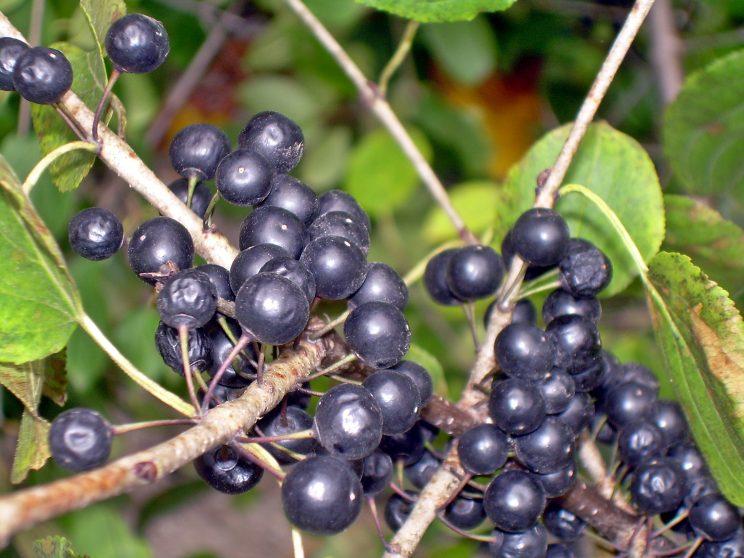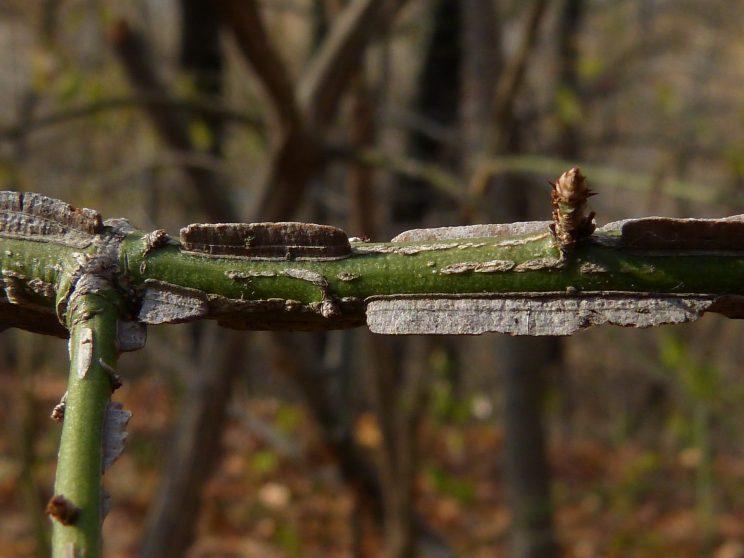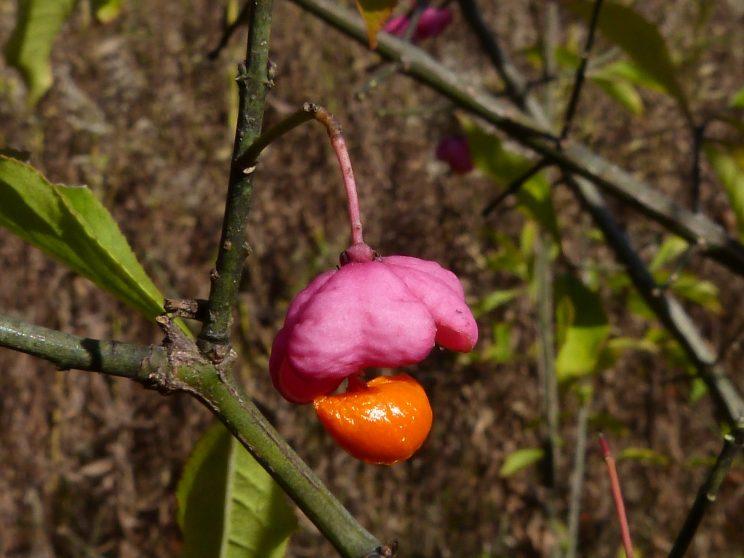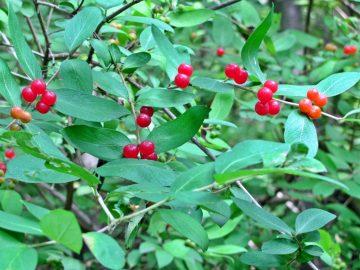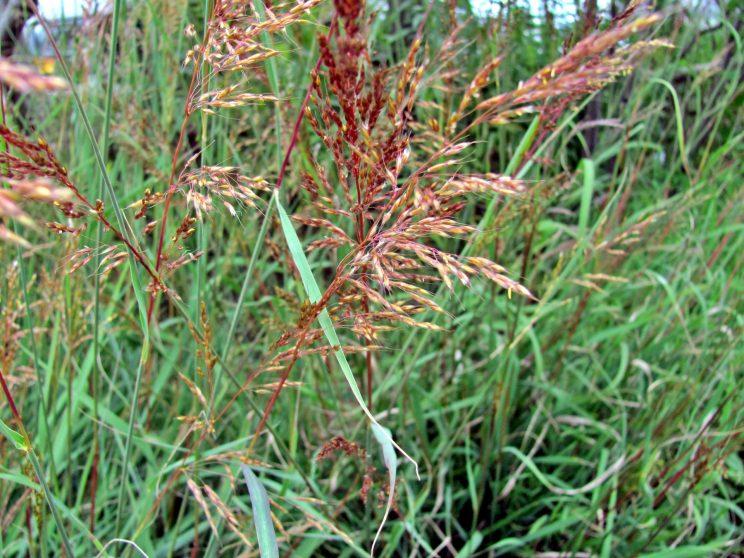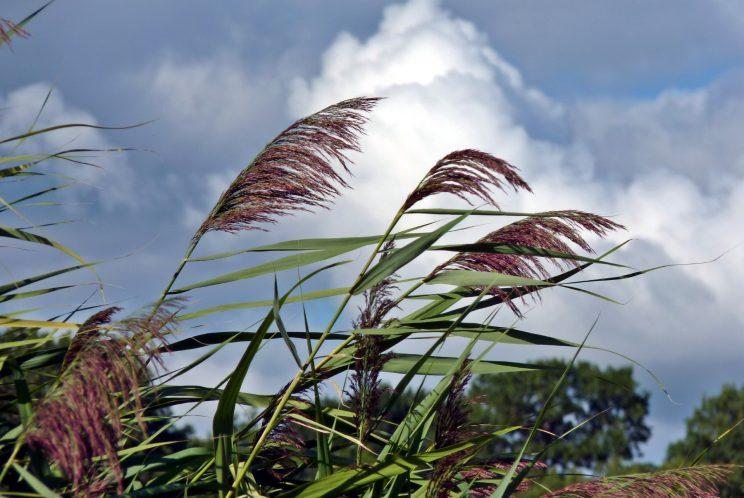by Andrew Dean & Emily Stairs
Invasive plants pose some of the greatest challenges to the preservation and restoration of High Park's natural environment. The ones described below are invasive woody plants (trees, shrubs and vines). There are also a number of invasive "herbaceous" species, plants that do not have woody stems.
To learn more about how City staff and volunteers are dealing with these species, see Controlling Invasive Plants and High Park Stewards.
Common/European Buckthorn (Rhamnus cathartica) & Glossy Buckthorn (R. frangula)
European and glossy buckthorn are highly aggressive invasive shrubs or small trees growing in dense groves, suppressing native tree and shrub seedlings due to heavy shading of its foliage (Tree Canada, 2007). Berries persist on branches throughout winter and are transported by some native birds and mice who favor the berries as year-round forage, facilitating its dispersal and colonization following defecation. It was imported from Asia and Europe as a windbreak species on farms and for erosion control and is now established in many disturbed habitats, especially woodlots. Able to thrive and invade a wide variety of environments, these highly adaptable buckthorns also have prolific seed crops which rapidly germinate.
Euonymus: European Spindletree (Euonymus europaeus) & Winged Euonymus (E. alatus)
Both euonymus species are known to invade forest understories, with European spindletree preferring the shrub layer while winged euonymus is more commonly found in forest edges.
European spindletree (Euonymus europaeus), also known as burning bush) very closely resembles and is easily confused with the provincially rare eastern wahoo or burning bush (Euonymus atropurpurea). Identification of these closely related shrubs can only be achieved when flowering, as vegetative growth characteristics are too similar. As a result, drupes should be left unless a positive identification has been verified during flowering. European spindletree has greenish white flowers in late May, compared with eastern wahoo with dark purple or maroon flowers appearing in June. Also, the spindletree holds its leaves much later into the fall in comparison to the native wahoo.
Winged euonymus (Euonymus alatus), also known as winged burning bush is distinctly different from Ontario’s rare and native burning bush or eastern wahoo (Euonymus atropurpurea). It is a dense, outward-arching shrub imported from Japan and produces abundant small red seed capsules with orange seeds on short stems which persist into the winter. Flowers are small, greenish-yellow with 4 petals. Stems are distinctively 4-winged, appearing square-stemmed.
Winged euonymus was first imported to North America in the 1860s as an ornamental, praised for its bright crimson-red foliage in the fall, and its propagation continues at nurseries for use in roadside plantings and in gardens. It is capable of invading a variety of disturbed habitats and is highly adaptable with a wide range of soil type and pH tolerance. As well, there are no threatening pest associations in North America and is tolerant of full shade conditions. Once established it out-competes native vegetation and forms dense colonies, thereby shading out and destroying the understory flora. Birds are the primary vector for seed dispersal, capable of carrying seeds long distances and generally germinate rapidly following defecation.
Asian Bittersweet (Celastrus orbiculatus)
This woody-perennial, vigorously growing vine you will likely see in High Park, climbing over and smothering vegetation. With alternate, tear-shaped leaves that are distinctly toothed and come to a point, Asian bittersweet has small greenish-yellow flowers, which bloom in the early summer months and begin to fruit in the fall. The small greenish-yellow fruits grow in clusters of 3-7 along the stem at the leaf axils, and split open to reveal a bright red inner fruit.
A native of Eastern Asia, Asian bittersweet is beginning to out-compete our native American bittersweet after escaping cultivation. Much like kudzu from the Southern US, it often kills vegetation from excessive shading or breakage – when it climbs high up on trees (up to 60 feet/17.3m), the increased weight can lead to uprooting and blow-over during high winds and heavy snowfalls.
Manual, mechanical and chemical control methods are all effective in removing and killing Asian bittersweet. In cases where vines are climbing up trees or buildings, a combination of cutting followed by application of concentrated systemic herbicide applications to rooted or living cut surfaces is likely to be the most effective approach. For larger infestations on the ground, a foliar herbicide may be the best choice, as manual or mechanical means could result in high soil disturbance.
Tartarian Honeysuckle (Lonicera tatatica)
Tartarian honeysuckle is a deciduous, opposite-leaved shrub (up to 3m) among the first to leaf out in spring with white, pink or red flowers developing in leaf axils. This open woodland, old field and shoreline invader was first imported from East Asia as an ornamental and historically planted by government agencies as wildlife shrubs. Birds and small mammals are known consumers of its bountiful seed crop and are agents for its dispersal in disturbed habitats. Also, the fused together pairs of red-orange berries persist throughout winter, effectively aiding in its proliferation once consumed by local fauna.
Tartarian honeysuckle is highly effective in out-competing native ground and understory vegetation, aggressively invading disturbed habitats. It threatens the long-term biodiversity of natural environments; invasion often forms a dense understory thicket which not only prevents growth of the herbaceous ground layer but tree seedlings as well. In fact, it is now among the most undesirable invasive species in central and eastern Ontario when considering its ability to displace native flora.
Norway Maple (Acer plantanoides)
Considered by many botanists an invasive, the exotic Norway maple is widely planted as a lawn and street tree, many of which are the full growing season red-leaved variety distinctly different from our native maples. It closely resembles sugar maple (Acer saccharum) and is easily identified by the milky white sap contained in the leaf petioles when removed from the branch. Owing to its success as an invader are results of dense canopies providing deep shading, a thick blanket of leaves which smother ground flora in the fall, highly viable winged seeds (called samaras) which readily blow into nearby natural areas and the root secretion of allelopathic chemicals preventing other native plants from establishing.
Having high shade tolerance, Norway maple produces abundant seedlings which are able to out-compete native flora in heavy shading conditions ultimately forming monocultures over time. Tolerance to harsh conditions including heavy shade and dry soils are known and favored in urban settings. Norway maple has no specific habitat preference and will thrive in any disturbed habitat. Control is achieved simply by cutting to or digging out of the ground, girdling and/or cutting any resprouts; herbicides are generally not required for successful eradication.
Tree of Heaven (Ailanthus altissima)
Tree of heaven, closely resembling native sumac (Rhus spp.) is a fast growing, aggressive and adaptable tree originally imported to North America from China. The leaves carry an unpleasant odor and are a good identification tool if bruised or crushed. Owing to its success in disturbed environments are spreading rhizomes (i.e. roots and shoots in the soil layer), abundant production of winged seeds and secretion of allelopathic chemicals, thereby preventing the growth, or sterilizing the soil for many native species.
Tree of heaven is also very tolerant of urban pollutants and as a result are often found in waste places such as ditches and roadsides where native trees aren’t able to establish. With a life span of 25 to 50 years, it can reach heights of 15 to 30 meters. Due to the rhizomatic spreading, root suckers often form groves or thickets and persist for up to centuries while providing a seed source for nearby disturbed areas.

